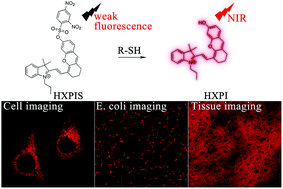A near-infrared water-soluble fluorescent probe for the detection of biothiols in living cells and Escherichia coli†
Abstract
As important members of the reactive sulfur species (RSS), biological thiols including cysteine, homocysteine and glutathione play crucial roles in many physiological and pathological processes. Development of highly sensitive and selective methods for biothiol detection is of great significance. In this work, we developed a hemicyanine based probe (HXPIS) for near-infrared fluorescence detection of biological thiols in living cells and tissues. The probe HXPIS is capable of detecting biothiols with high selectivity as well as low detection limit (less than 11 nM). In addition, confocal laser scanning microscopy experiments of HeLa cells and Escherichia coli showed that HXPIS could be used to monitor intracellular and bacterial levels of biothiols. Furthermore, HXPIS was applied to distinguish live and dead Escherichia coli. Finally, the imaging of rat liver tissue slices demonstrated the outstanding staining and penetrating ability of the near infrared fluorescent probe.



 Please wait while we load your content...
Please wait while we load your content...